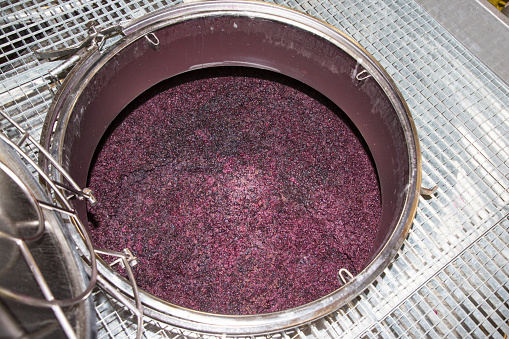
« What does the bottle matter as long as we are drunk... » (Alfred de Musset)
French land has always been famous for its alcohols and more particularly its viticulture it had for a long time.
To turn grapes into an alcoholic drink, the winegrower, such ads André Brunel, must put the fruit through many complex stages but well mastered thanks to the know-how and tradition.
The alcoholic fermentation is the best known: it turns the yeasts into sugar, then producing alcohol.
But another fermentation, called malolactic, is also used to produce mainly great vintages of red wines.
An extremely recent expertise
First studied in the 19th century, the malolactic fermentation (or FML or “malo” for the specialists) has been truly mastered since the 1960s
How does malolactic fermentation work?
Also called “second fermentation” starts after the alcoholic fermentation (or more rarely at the same time).
Whereas the alcoholic fermentation starts naturally as soon as the musts are put to ferment because of the present natural yeasts: the “malo” starts because the winemaker as decided to make it begin, it’s his own choice which will have a role on the wine taste.
The FML is due to lactic bacteria which, once all the sugars have been transformed into alcohol during alcoholic fermentation will transform malic acid into lactic acid causing a release of CO2.
If sometimes the bacterium is naturally present on some stocks or some grape varieties, malolactic fermentation can also be caused by the decision of the winegrower who will sow some grape varieties that need a FML with some bacteria.
This action is called “co-sowing”; this practice is particularly used for young wines such as “Beaujolais nouveau”.
The effect of the “malo”
The FML will be researched for the effects it produces on the wine.
- Frist of all, the lactic acids of the “malo” will permit to get a fuller wine, so a softening of the wine, as well as a lower acidity. We understand then why this fermentation is particularly searched for wines made with grapes which were not completely mature.
- Lastly, the “malo” will diminish the presence of tannins making them softer.
This depends completely on the choice of the winemaker according to the taste and the aroma he wants to give to his cuvée.
- For the white wines of Mediterranean areas (or warm generally speaking): the white wines of these areas do not have enough natural acidity, because of the sun which gives a lot of sugar to grapes. In this case, we avoid the malolactic fermentation to protect the low natural acidity.
- For the white wines of temperate areas: Since these white wines have a natural acidity it’s the decision of the winemaker will use as he wishes the “malo” to give aroma and softness to his cuvée
- For the red wines: The FML is automatic or almost automatic because it stabilizes the aromas, the tannins and the softness of the wine. Reducing acidity, the “malo” permits a better wine aging.
How to practice the FML
In order to get a successful malolactic fermentation of a wine, a strict process must be respected: it’s easy to fail the “malo”.
- The temperature must be absolutely between 20-22°C so as to let the bacteria develop.
- As soon as the FML is finished, to prevent bacteria from degrading the wine by unwanted aromas, racking and sulfating the wine must be done immediately.
For knowing if the FML is finished, the winegrowers use a paper chromatography that show the progression/migration of the acids. If there no malic acid stain in the middle of the sheet of paper, it means the end of the fermentation.
The “malo” lasts between 8 and 10 days, mid-November shows the end of the fermentation. It takes place in wooden, stainless-steel vats or in barrels that have been used for the alcoholic fermentation.
Smart winemakers know that if a “malo” is a success, it’s a clever idea to save the unsulphurized lees from tank to seed it in another one. Thus, they must know very well microbiology to be able to make good wines: the vinification is scientific.
But be careful, an uncontrolled “malo” will bring unwanted tastes to your win, an unpleasant bitterness by producing bad bacteria.
To find out more about our expertise and our vintages, visit our Estate!
Published : 2022-11-02

